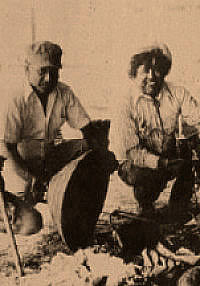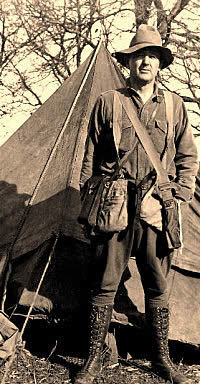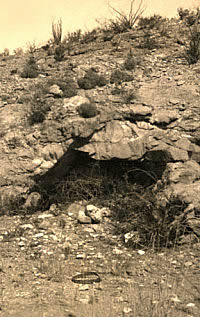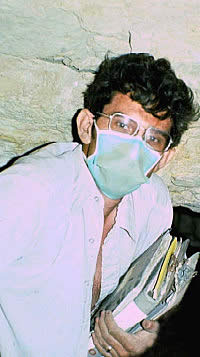
Pecos land surveyor Frank Granado,
right, discovered the Rustler Hills cave which later
was named for him and shared his artifact collection
with archeologists.
|

E.B. (Ted) Sayles worked briefly
in area rockshelters in 1932 during a statewide archeological
survey and helped call attention to the region's archeological
potential. He is shown here at his camp during survey
in north Texas. TARL archives.
|

Shelby Brooks cave, one of the few
sites that had been studied in the region prior to the
1978 excavation at nearby Granado Cave. TARL archives.
|
|
In 1976, Frank Granado, a surveyor
from the nearby town of Pecos discovered prehistoric burials
in a previously unknown cave in the Rustler Hills. An article
soon appeared in the local paper. The site was brought to
the attention of Curtis Tunnell, then the state archeologist
of Texas. Tunnell recalled that archeologist Donny
L. Hamilton was raised in Pecos and thought he might
be interested in following up on the newspaper account. Hamilton,
then a graduate student at the University of Texas at Austin,
jumped at the chance.
Hamilton met with Granado and arranged to see
the cave, which was located near Caldwell Shelter
No. 1 and Brooks Cave, both fairly
well known and significant archeological sites. Granado Cave
was named after its discoverer and given the official archeological
designation 41CU8. Ready to advance the project, Mr. Granado
allowed Hamilton to study his private collection of artifacts
from the site.
Several months later, Hamilton returned to Granado
Cave with a small archeological crew to document the site
and carry out test excavations. The rich archeological potential
of the cave soon became evident. Recognizing this, Shelby
Brooks, the owner of the land on which Granado Cave
and Brooks Cave are located, allowed both sites to be nominated
for designation as State Archeological Landmarks
(SALs). As such, they became the first SALs located on private
property in Texas.
Previous Archeological Research
Over the years, many of the various caves and
sinkholes of the Rustler Hills have been explored and partially
dug up by treasure hunters, artifact collectors, and early
archeologists. In 1932, archeologist E. B. (Ted) Sayles
of the Gila Pueblo research center in Arizona spent a few
days digging at two rockshelters that became known as the
Caldwell Shelters. His work was rudimentary
and only sketchily reported, but he did call attention to
the area's archeological significance. Two years later, A.
T. Jackson of the University of Texas and a small
crew of assistants spent five weeks excavating at five sites
in the Rustler Hills. This work was also poorly reported and
Jackson failed to note that two of the sites were the Caldwell
Shelters where Sayles had previously dug. This led to considerable
confusion in the archeological records that was not sorted
out for many decades.
Among the important sites that archeologists
have documented near Granado Cave are the Caldwell Shelters
(41CU1 and 41CU2), the McAlpin Caves (41CU5 and 41CU6), Brooks
Cave (41CU7), and ELCOR Cave (no assigned site number). Although
none of these sites were systematically excavated and reported,
the unusually well-preserved artifacts and burials found at
the caves and shelters in the Rustler Hills have the potential
to tell us much about prehistoric life in the area. Hamilton's
work at Granado Cave in 1976 and 1978 was the first modern
scientific dig in the area.
|

Archeologist Donny Hamilton in Granado
Cave in 1978. He and other excavators wore the more
comfortable surgical masks (unlike those shown below)
to keep from inhaling the clouds of dust stirred up
during excavation and screening of the cave fill.
Click images to enlarge
|

Entrance to Caldwell Shelter Number
1 (41CU1). This site was excavated by archeologist E.B.
Sayles in 1932 and again by A. T. Jackson of the University
of Texas in 1934. Both archeologists recovered many
of the same kinds of perishable artifacts found in Granado
Cave. Unfortunately, their work was rudimentary and
the brief published accounts left much to be desired.
|

Workers wearing respirators and
carbide head lamps brush off dust following a hard day's
work in Shelby Brooks cave, 1934. Excavated by A.T.
Jackson, the Shelby Brooks site, like Granado, was a
dry cave with burials and other well-preserved cultural
materials. TARL archives. Click to see full image.
|
|